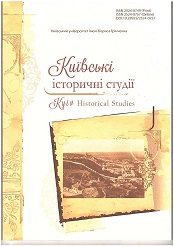MOLDAVIAN AUTONOMOUS SOVIET SOSIALIST REPUBLIK AS PART OF THE USSR IN 1924–1940s: TO THE ISSUE OF HISTORICAL ROOTS OF MODERN PROBLEM OF TRANSNISTRIA
DOI:
https://doi.org/10.28925/2524-0757.2016.1.4Keywords:
Moldavian Autonomous Soviet Socialist Republic, historiography, administrative changes, Transnistrian problemAbstract
The article studies the problem of the formation, characteristics of socio-economic, political and ethno-cultural development, and MARSR elimination in the context of the contemporary problem of Transnistria. Moldavian Autonomous Soviet Socialist Republic existed in the USSR from 1924 to 1940. Its formation has led to signifi cant changes in administrative-territorial structure of the region and laid the preconditions Transnistria problem in the future. The territory of Left-bank Transnistria was fi nally annexed by the Russian Empire after signing memorandum between the Russian and Ottoman empires in 1792. From the 18th century to the early 20th century Transnistria was not a single territorial-administrative unit. The southern part of Transnistria was the part of the district of Tiraspol, Kherson province, the northern part — Balta and Olhopolsk counties of Podolia. The Bolshevik coup in October 1917 and the occupation of Bessarabia by Romania contributed the growth of the value of in Transnistria geopolitical direction in Balkans. The decision to form the Moldavian Autonomous Socialist Republic was arrived at the 3rd session of the All-Ukrainian Central Executive Committee of the 8th convocation on October 12, 1924 in Kharkiv. In the west and south-west the border of the Autonomous Republic was coincided with the state border of the USSR. This meant that part of the Moldavian Autonomous Soviet Socialist Republic de jure included the territory of Bessarabia, which was the part of Romania. Being the part of the Republic, the territory saved the structure of the city, district and village administrative units, institutions and organizations that fell under the authority of the Revolutionary Committee of the Autonomous Republic with the administrative staff and property. Massive administrative changes took place in Transnistria in summer 1940, when MARSR was eliminated, and its part joined the Moldavian Soviet Socialist Republic. In August 1940, as a matter of releasing Bessarabia from the Romanian occupation and joining the Soviet Union, the Moldavian Autonomous Soviet Socialist Republic stopped to prevail. The entry of Bessarabia to Transnistria to Bessarabia in 1940 did not meet the laws of the USSR and the Ukrainian SSR. The highest state authorities of the USSR, the Ukrainian SSR and MARSR had not accepted all the necessary legal acts. The issue of new republic’s borders was resolved by the command-administrative methods. During the Soviet-German war of 1941–1945 fascist invaders made the Dniester River a border ones. The “Bessarabia” governorship was created on the territory between the Prut and Dniester rivers, to the east from the Dnister, Governor “Transnistria” was created with an administrative center in Odesa. Transnistria liberation by the Red Army in April 1944 led to the restoration of the borders of the Moldavian SSR in 1940 Moldavian SSR as state union lasted more than half a century. In June 1990 the Parliament of Moldova abolished the Act of August 2, 1940, according to which this republic was founded. The management of Moldova dramatically changed the geopolitical orientation of Slavic direction towards Romania.
Downloads
References
Aft enyuk S.L. Leninskaya natsionalnaya politika i obrazovanie sovetskoy gosudarstvennosti moldavskogo naroda / S.L. Aft enyuk. — Kishinev : Kartya moldovenyaske, 1971. — 392 c.
Boiechko V.D. Utvorennia Moldavskoi Avtonomnoi Sotsialistychnoi Radyanskoi Respubliky i «Bessarabske pytannia» / V.D. Boiechko // Problemy istorii Ukrainy: fakty, sudzhennia, poshuky: mizhvid. zb. nauk. pr. / vidp. red. S.V. Kulchytskyi. — K., 1994. — Vyp. 3. — S. 25–32.
Vilenskiy B.V. Obrazovanie Moldavskoy Sovetskoy Socialisticheskoy respubliki : avtoref. dis. … k.yu.n. / B.V. Vilenskiy. — Kiev, 1951. — 22 s.
Vsesoyuznaya perepis naseleniya 1926 goda. USSR: itogi po respublike. — M., 1930. — T. 6. — 204 c.
Ivanova Z.M. Levoberezhnye rayony Moldavii v 1918–1924 gg.: istoricheskiy ocherk / Z.M. Ivanova. — Kishinev : Shtiintsa, 1979. — 216 s.
Istoriya Pridnestrovskoy Moldavskoy Respubliki : v 2 t. [Babilunga N.V. i dr.]. — Tiraspol : Rodina,1996. — T. 1. — 388 s.
Lazarev A.M. Vossoedinenie moldavskogo naroda v yedinoye sovetskoye gosudarstvo / A.M. Lazarev. — Kishinev : Kartya moldovenyaske, 1965. — 206 c.
Nachalo bolshogo puti: sbornik dokumentov i materialov / sost.: N.K. Bibileyshvili i dr. — Kishinev : Partizdat pri CK KP Moldavii 1964. — 152 s.
Repida A. Obrazovanie Moldavskoy ASSR. — Kishinev : Shtiintsa, 1974. — 184 s.
Tsentralnyi derzhavnyi arkhiv hromadskykh obiednan Ukrainy (TsDAHO Ukrainy). — F. 29. — Op. 1. — Spr. 1090. — 132 ark.
TsDAHO Ukrainy. — F. 29. — Op. 1. — Spr. 1184. — 84 ark.
Published
How to Cite
Issue
Section
License
Copyright (c) 2016 Kyiv Historical Studies

This work is licensed under a Creative Commons Attribution-NonCommercial-ShareAlike 4.0 International License.
Authors who publish in this journal retain the right of authorship of the work and give to the journal right of first publication of this work under the conditions of Creative Commons: Attribution-NonCommercial-ShareAlike 4.0 International (CC BY-NC-SA 4.0), which allows others freely distribute the work published with reference to the authors of the original work and the first publication of this magazine.














